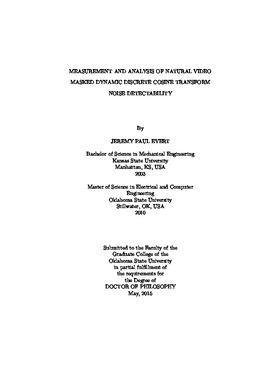| dc.contributor.advisor | Chandler, Damon | |
| dc.contributor.author | Evert, Jeremy Paul | |
| dc.date.accessioned | 2016-09-29T18:33:51Z | |
| dc.date.available | 2016-09-29T18:33:51Z | |
| dc.date.issued | 2015-05 | |
| dc.identifier.uri | https://hdl.handle.net/11244/45163 | |
| dc.description.abstract | Lossy video compression lowers fidelity and can leave visual artifacts. Current video compression algorithms are guided by quality assessment tools designed around subjective data based on aggressive video compression. However, most consumer video is of high quality with few detectable visual artifacts. A better understanding of the visual detectability of such artifacts is crucial for improved video compression. Current techniques of predicting artifact detectability in videos have been largely guided by studies using no masks or using still-image masks. There is limited data quantifying the detectability of compression artifacts masked by natural videos. In this paper, we investigate the effect of natural video masks on the detectability of time-varying DCT basis function compression artifacts. We validate the findings from Watson et al. [JEI 2001], who found that as these artifacts increase in spatial and temporal frequency, detection contrast thresholds tend to increase. We extend this work by presenting compression artifacts with natural videos; when artifacts are shown with natural videos, this relationship between artifact spatial frequency and threshold is reduced or even reversed (our data suggests that some natural videos make targets easier to detect). More generally, our results demonstrate that different videos have different effects on artifact detectability. A model using target and video properties to predict target detection thresholds summarizes these results. We expand these results to examine the relationship between mask luminance, contrast, and playback rates on compression artifact detectability. We also examine how the detectability of targets that are spatially correlated with mask content differ from the detectability of uncorrelated targets. This paper's data serves to fill-in an understanding gap in natural-video masking, and it supports future video compression research. | |
| dc.format | application/pdf | |
| dc.language | en_US | |
| dc.rights | Copyright is held by the author who has granted the Oklahoma State University Library the non-exclusive right to share this material in its institutional repository. Contact Digital Library Services at lib-dls@okstate.edu or 405-744-9161 for the permission policy on the use, reproduction or distribution of this material. | |
| dc.title | Measurement and analysis of natural video masked dynamic discrete cosine transform noise detectability | |
| dc.contributor.committeeMember | Teague, Keith A. | |
| dc.contributor.committeeMember | Fan, Guoliang | |
| dc.contributor.committeeMember | Cecil, Joe | |
| osu.filename | Evert_okstate_0664D_13870.pdf | |
| osu.accesstype | Open Access | |
| dc.type.genre | Dissertation | |
| dc.type.material | Text | |
| thesis.degree.discipline | Electrical Engineering | |
| thesis.degree.grantor | Oklahoma State University | |
